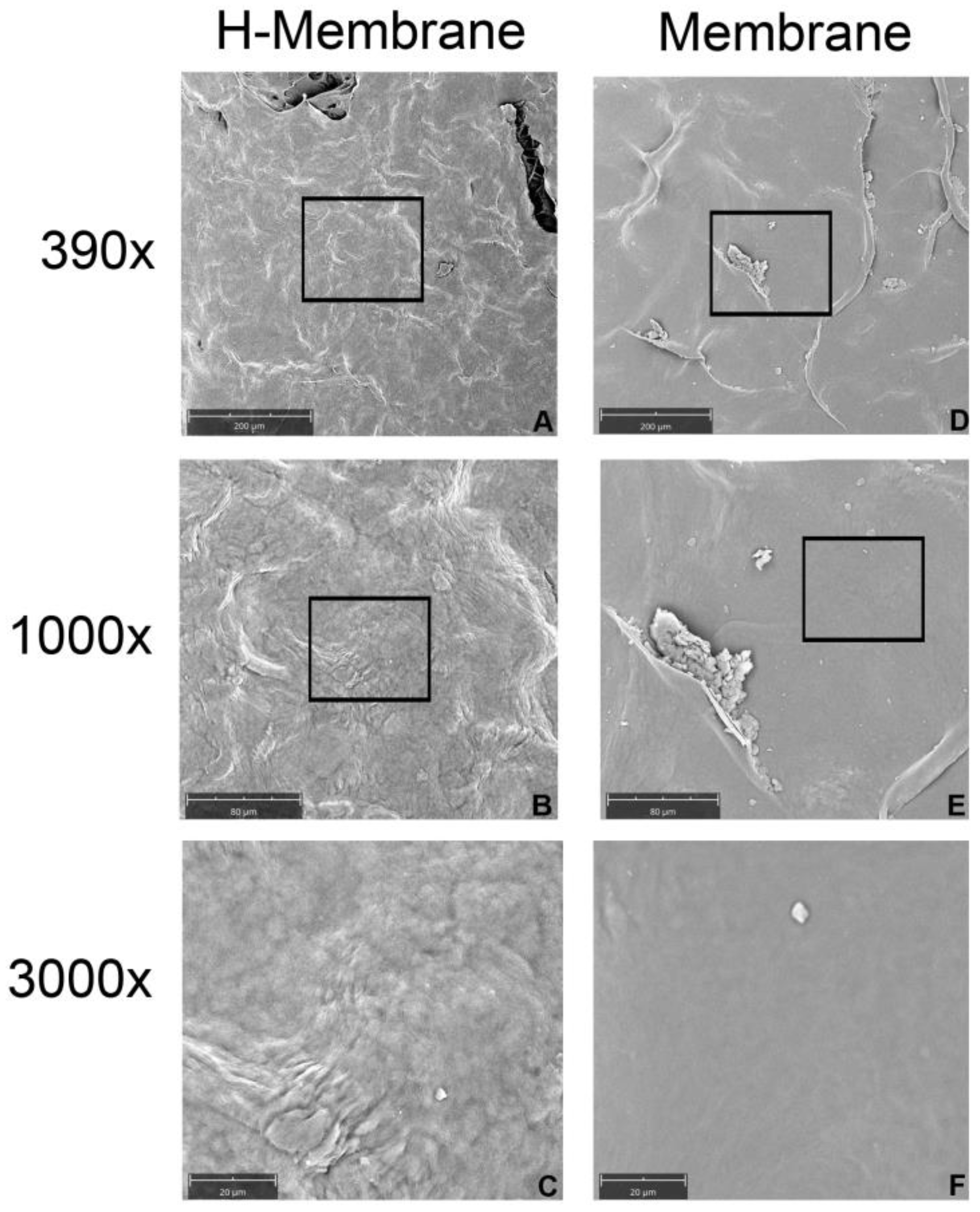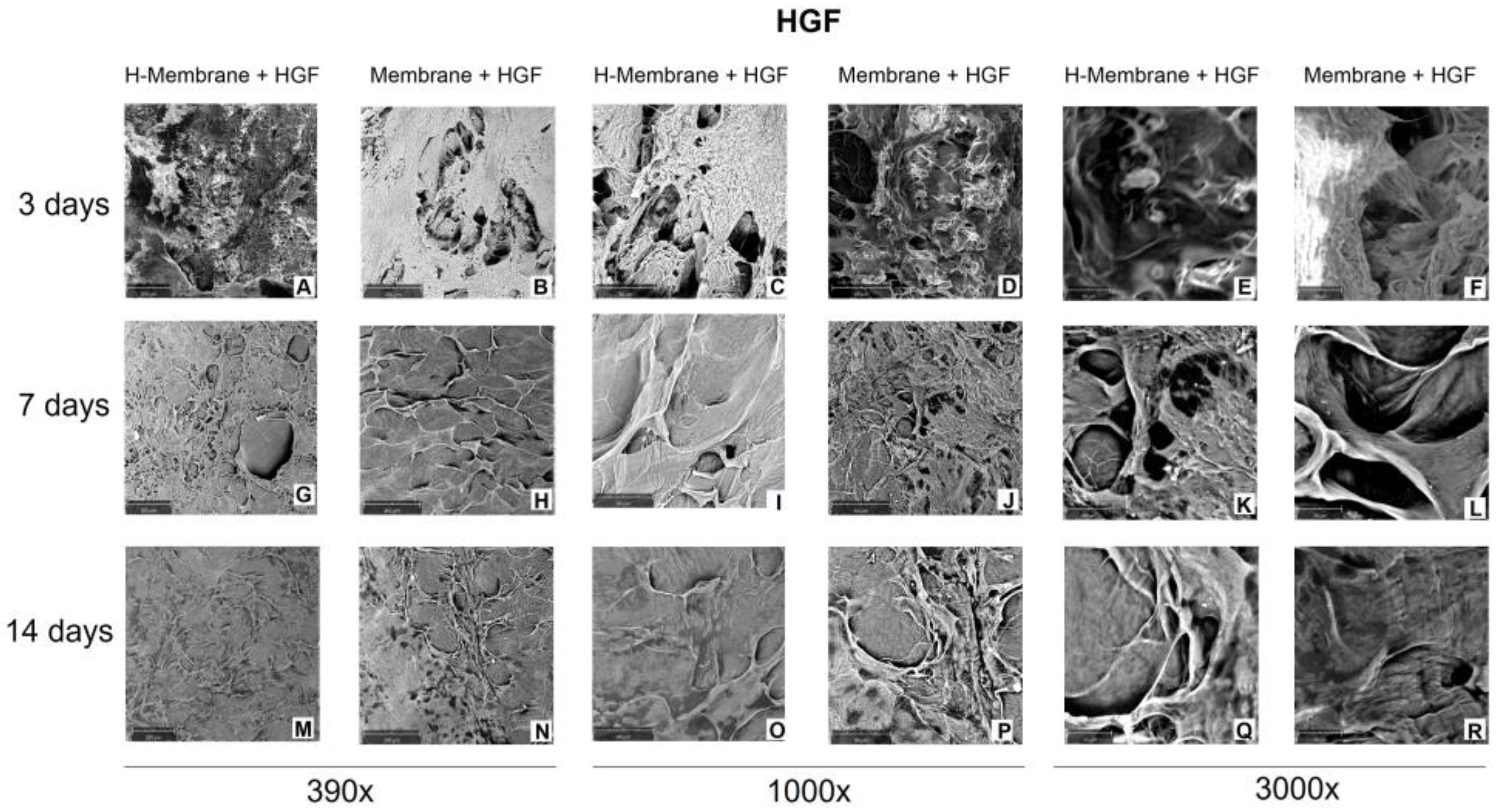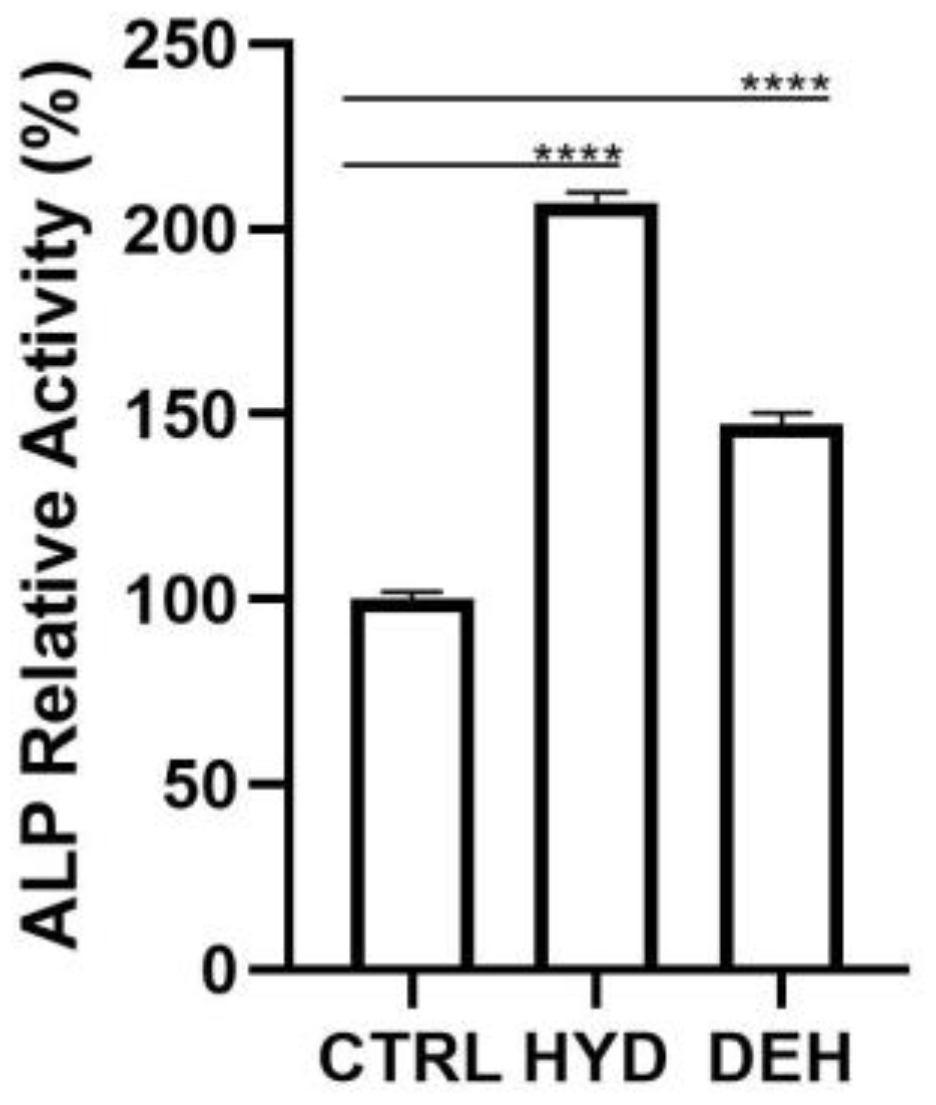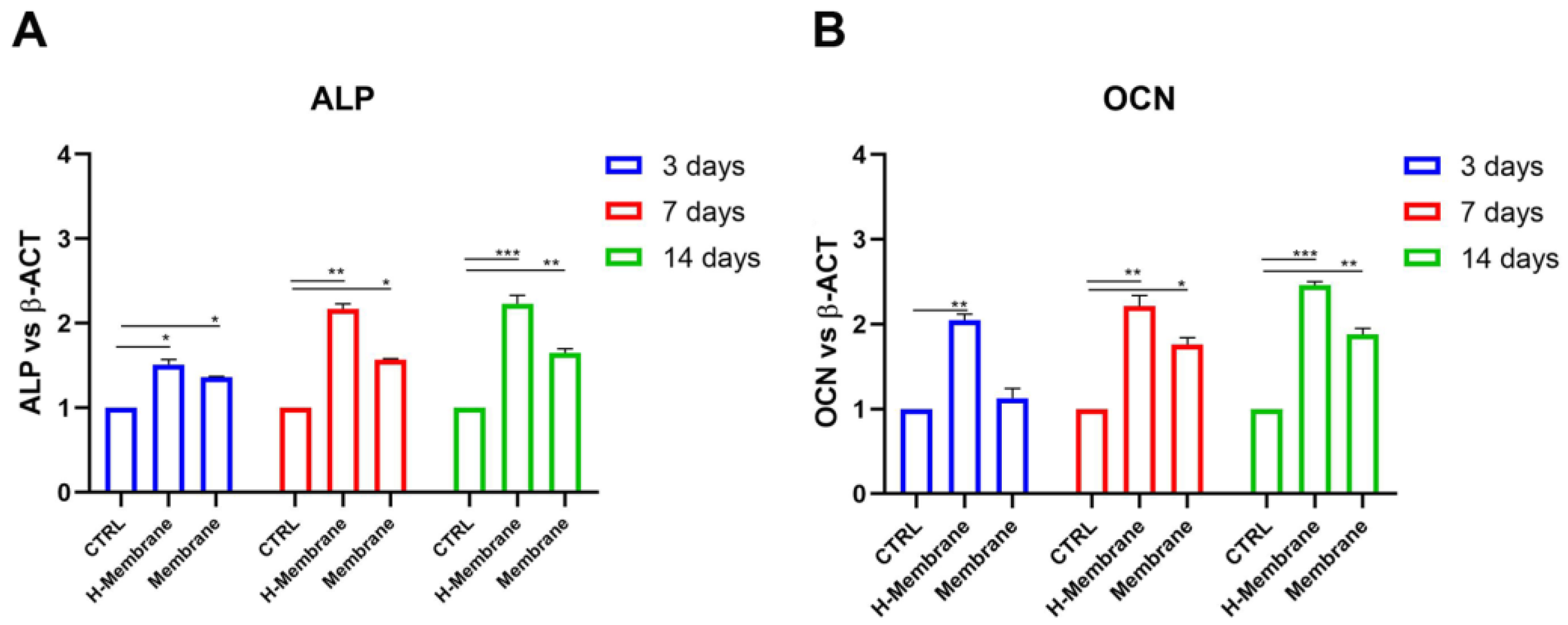Osteoblasts and Fibroblasts Interaction with a Porcine Acellular Dermal Matrix Membrane
Abstract
1. Introduction
2. Results
2.1. Characterization of the Membrane
2.2. Biological Activity
2.2.1. Cell Proliferation
2.2.2. Cell Attachment and Cell Morphology
2.2.3. Cell Interaction with the Membrane
2.2.4. ALP Activity
2.2.5. Mineralization
2.2.6. Gene Expression in Gingival Fibroblasts and Osteoblasts
3. Discussion
4. Materials and Methods
4.1. Experimental Design
- i.
- CTRL: cells seeded on the plate;
- ii.
- H-Membrane: cells cultured on the matrix hydrated three times with NaCl 0.9%;
- iii.
- Membrane: cells seeded on the membrane used as manufactured.
4.2. Characterization of the Material
4.2.1. SEM Analyses
4.2.2. Histological Analysis
4.3. Biological In Vitro Tests
4.3.1. Cell Isolation
4.3.2. Cell Culture
4.3.3. Cell Viability
4.3.4. Cell Adhesion
4.3.5. Cell Interaction with the Membrane
4.3.6. ALP Assay
4.3.7. Alizarin Red Staining and Quantification of Calcium Deposition
4.3.8. Gene Expression
4.3.9. Statistical Analysis
5. Conclusions
Author Contributions
Funding
Institutional Review Board Statement
Informed Consent Statement
Data Availability Statement
Acknowledgments
Conflicts of Interest
References
- Elgali, I.; Omar, O.; Dahlin, C.; Thomsen, P. Guided Bone Regeneration: Materials and Biological Mechanisms Revisited. Eur. J. Oral Sci. 2017, 125, 315–337. [Google Scholar] [CrossRef]
- Maluta, R.; Monteiro, M.F.; Peruzzo, D.C.; Joly, J.C. Root Coverage of Multiple Gingival Recessions Treated with Coronally Advanced Flap Associated with Xenogeneic Acellular Dermal Matrix or Connective Tissue Graft: A 6-Month Split-Mouth Controlled and Randomized Clinical Trial. Clin. Oral Investig. 2021, 25, 5765–5773. [Google Scholar] [CrossRef]
- Fickl, S.; Therese Kröger, A.; Dietrich, T.; Kebschull, M. Influence of Soft Tissue Augmentation Procedures around Dental Implants on Marginal Bone Level Changes-A Systematic Review. Clin. Oral Implants Res. 2021, 32 (Suppl. S21), 108–137. [Google Scholar] [CrossRef]
- Araújo, M.G.; Lindhe, J. Dimensional Ridge Alterations Following Tooth Extraction. An Experimental Study in the Dog. J. Clin. Periodontol. 2005, 32, 212–218. [Google Scholar] [CrossRef] [PubMed]
- Pabst, A.M.; Happe, A.; Callaway, A.; Ziebart, T.; Stratul, S.I.; Ackermann, M.; Konerding, M.A.; Willershausen, B.; Kasaj, A. In Vitro and in Vivo Characterization of Porcine Acellular Dermal Matrix for Gingival Augmentation Procedures. J. Periodontal. Res. 2014, 49, 371–381. [Google Scholar] [CrossRef]
- Wessel, J.R.; Tatakis, D.N. Patient Outcomes Following Subepithelial Connective Tissue Graft and Free Gingival Graft Procedures. J. Periodontol. 2008, 79, 425–430. [Google Scholar] [CrossRef] [PubMed]
- Barbeck, M.; Lorenz, J.; Kubesch, A.; Bohm, N.; Booms, P.; Choukroun, J.; Sader, R.; Kirkpatrick, C.J.; Ghanaati, S. Porcine Dermis-Derived Collagen Membranes Induce Implantation Bed Vascularization Via Multinucleated Giant Cells: A Physiological Reaction? J. Oral Implantol. 2015, 41, e238–e251. [Google Scholar] [CrossRef]
- Lin, Z.; Nica, C.; Sculean, A.; Asparuhova, M.B. Enhanced Wound Healing Potential of Primary Human Oral Fibroblasts and Periodontal Ligament Cells Cultured on Four Different Porcine-Derived Collagen Matrices. Materials 2020, 13, 3819. [Google Scholar] [CrossRef]
- Saghiri, M.A.; Asatourian, A.; Garcia-Godoy, F.; Sheibani, N. The Role of Angiogenesis in Implant Dentistry Part II: The Effect of Bone-Grafting and Barrier Membrane Materials on Angiogenesis. Med. Oral Patol. Oral Cir. Bucal 2016, 21, e526–e537. [Google Scholar] [CrossRef] [PubMed]
- Guarnieri, R.; Reda, R.; Di Nardo, D.; Miccoli, G.; Zanza, A.; Testarelli, L. In Vitro Direct and Indirect Cytotoxicity Comparative Analysis of One Pre-Hydrated versus One Dried Acellular Porcine Dermal Matrix. Materials 2022, 15, 1937. [Google Scholar] [CrossRef] [PubMed]
- Nica, C.; Lin, Z.; Sculean, A.; Asparuhova, M.B. Adsorption and Release of Growth Factors from Four Different Porcine-Derived Collagen Matrices. Materials 2020, 13, 2635. [Google Scholar] [CrossRef]
- Sorushanova, A.; Delgado, L.M.; Wu, Z.; Shologu, N.; Kshirsagar, A.; Raghunath, R.; Mullen, A.M.; Bayon, Y.; Pandit, A.; Raghunath, M.; et al. The Collagen Suprafamily: From Biosynthesis to Advanced Biomaterial Development. Adv. Mater. 2019, 31, 1801651. [Google Scholar] [CrossRef]
- de Santana, R.B.; de Mattos, C.M.L.; Francischone, C.E.; van Dyke, T. Superficial Topography and Porosity of an Absorbable Barrier Membrane Impacts Soft Tissue Response in Guided Bone Regeneration. J. Periodontol. 2010, 81, 926–933. [Google Scholar] [CrossRef]
- Espósito, A.C.C.; Brianezi, G.; Miot, L.D.B.; Miot, H.A. Fibroblast Morphology, Growth Rate and Gene Expression in Facial Melasma. An. Bras. Dermatol. 2022, 97, 575–582. [Google Scholar] [CrossRef]
- Seetharaman, S. OBSOLETE: Fundamentals of Metal Matrix Composites. In Reference Module in Materials Science and Materials Engineering; Elsevier: Amsterdam, The Netherlands, 2021. [Google Scholar] [CrossRef]
- Czekanska, E.M.; Stoddart, M.J.; Richards, R.G.; Hayes, J.S. In Search of an Osteoblast Cell Model for in Vitro Research. Eur. Cell Mater. 2012, 24, 1–17. [Google Scholar] [CrossRef] [PubMed]
- Shekaran, A.; García, A.J. Extracellular Matrix-Mimetic Adhesive Biomaterials for Bone Repair. J. Biomed. Mater. Res. A 2011, 96, 261–272. [Google Scholar] [CrossRef]
- Chan, M.W.C.; El Sayegh, T.Y.; Arora, P.D.; Laschinger, C.A.; Overall, C.M.; Morrison, C.; McCulloch, C.A.G. Regulation of Intercellular Adhesion Strength in Fibroblasts. J. Biol. Chem. 2004, 279, 41047–41057. [Google Scholar] [CrossRef] [PubMed]
- Swaminathan, R. Biochemical Markers of Bone Turnover. Clin. Chim. Acta 2001, 313, 95–105. [Google Scholar] [CrossRef]
- Price, J. Bone Biomarkers. In Diagnosis and Management of Lameness in the Horse, 2nd ed.; WB Saunders: Philadelphia, PA, USA, 2011; pp. 947–952. [Google Scholar] [CrossRef]
- Zhu, L.; Yao, Y.; Liu, J.; Wang, J.; Xie, H. Expression of Β-catenin and MMP-8 in Gingival Crevicular Fluid and Gingival Tissue Indicates the Disease severity of Patients with Chronic Periodontitis. Exp. Ther. Med. 2019, 18, 2131–2139. [Google Scholar] [CrossRef]
- Hanemaaijer, R.; Sorsa, T.; Konttinen, Y.T.; Ding, Y.; Sutinen, M.; Visser, H.; van Hinsbergh, V.W.M.; Helaakoski, T.; Kainulainen, T.; Rönkä, H.; et al. Matrix Metalloproteinase-8 Is Expressed in Rheumatoid Synovial Fibroblasts and Endothelial Cells. Regulation by Tumor Necrosis Factor-Alpha and Doxycycline. J. Biol. Chem. 1997, 272, 31504–31509. [Google Scholar] [CrossRef] [PubMed]
- Nwomeh, B.C.; Liang, H.X.; Cohen, I.K.; Yager, D.R. MMP-8 Is the Predominant Collagenase in Healing Wounds and Nonhealing Ulcers. J. Surg. Res. 1999, 81, 189–195. [Google Scholar] [CrossRef]
- Gutiérrez-Fernández, A.; Inada, M.; Balbín, M.; Fueyo, A.; Pitiot, A.S.; Astudillo, A.; Hirose, K.; Hirata, M.; Shapiro, S.D.; Noël, A.; et al. Increased Inflammation Delays Wound Healing in Mice Deficient in Collagenase-2 (MMP-8). FASEB J. 2007, 21, 2580–2591. [Google Scholar] [CrossRef] [PubMed]
- Danielsen, P.L.; Holst, A.V.; Maltesen, H.R.; Bassi, M.R.; Holst, P.J.; Heinemeier, K.M.; Olsen, J.; Danielsen, C.C.; Poulsen, S.S.; Jorgensen, L.N.; et al. Matrix Metalloproteinase-8 Overexpression Prevents Proper Tissue Repair. Surgery 2011, 150, 897–906. [Google Scholar] [CrossRef] [PubMed]
- Kuula, H.; Salo, T.; Pirilä, E.; Tuomainen, A.M.; Jauhiainen, M.; Uitto, V.J.; Tjäderhane, L.; Pussinen, P.J.; Sorsa, T. Local and Systemic Responses in Matrix Metalloproteinase 8-Deficient Mice during Porphyromonas Gingivalis-Induced Periodontitis. Infect. Immun. 2009, 77, 850–859. [Google Scholar] [CrossRef]
- Yang, Z.; Wu, C.; Shi, H.; Luo, X.; Sun, H.; Wang, Q.; Zhang, D. Advances in Barrier Membranes for Guided Bone Regeneration Techniques. Front. Bioeng. Biotechnol. 2022, 10, 921576. [Google Scholar] [CrossRef]
- Ye, H.; Zhu, J.; Deng, D.; Jin, S.; Li, J.; Man, Y. Enhanced Osteogenesis and Angiogenesis by PCL/Chitosan/Sr-Doped Calcium Phosphate Electrospun Nanocomposite Membrane for Guided Bone Regeneration. J. Biomater. Sci. Polym. Ed. 2019, 30, 1505–1522. [Google Scholar] [CrossRef]
- Wang, Y.; Jiang, Y.; Zhang, Y.; Wen, S.; Wang, Y.; Zhang, H. Dual Functional Electrospun Core-Shell Nanofibers for Anti-Infective Guided Bone Regeneration Membranes. Mater. Sci. Eng. C Mater. Biol. Appl. 2019, 98, 134–139. [Google Scholar] [CrossRef]
- Fujioka-Kobayashi, M.; Schaler, B.; Shirakata, Y.; Nakamura, T.; Noguchi, K.; Zhang, Y.; Miron, R. Comparison of Two Porcine Collagen Membranes Combined with RhBMP-2 and RhBMP-9 on Osteoblast Behavior In Vitro. Int. J. Oral Maxillofac. Implants 2017, 32, e221–e230. [Google Scholar] [CrossRef]
- Fujioka-Kobayashi, M.; Caballé-Serrano, J.; Bosshardt, D.D.; Gruber, R.; Buser, D.; Miron, R.J. Bone Conditioned Media (BCM) Improves Osteoblast Adhesion and Differentiation on Collagen Barrier Membranes. BMC Oral Health 2016, 17, 1–7. [Google Scholar] [CrossRef]
- Miron, R.; Fujioka-Kobayashi, M.; Buser, D.; Zhang, Y.; Bosshardt, D.; Sculean, A. Combination of Collagen Barrier Membrane with Enamel Matrix Derivative-Liquid Improves Osteoblast Adhesion and Differentiation. Int. J. Oral Maxillofac. Implants 2017, 32, 196–203. [Google Scholar] [CrossRef]
- Babuska, V.; Dobra, J.; Kulda, V.; Kripnerova, M.; Moztarzadeh, A.; Bolek, L.; Lahoda, J.; Hrusak, D. Comparison of Fibroblast and Osteoblast Response to Cultivation on Titanium Implants with Different Grain Sizes. J. Nanomater. 2015, 3, 1–9. [Google Scholar] [CrossRef]
- Davies, J.T.; Lam, J.; Tomlins, P.E.; Marshall, D. An in Vitro Multi-Parametric Approach to Measuring the Effect of Implant Surface Characteristics on Cell Behaviour. Biomed. Mater. 2010, 5, 015002. [Google Scholar] [CrossRef] [PubMed]
- Miao, X.; Wang, D.; Xu, L.; Wang, J.; Zeng, D.; Lin, S.; Huang, C.; Liu, X.; Jiang, X. The Response of Human Osteoblasts, Epithelial Cells, Fibroblasts, Macrophages and Oral Bacteria to Nanostructured Titanium Surfaces: A Systematic Study. Int. J. Nanomed. 2017, 12, 1415–1430. [Google Scholar] [CrossRef] [PubMed]
- Allahyari, Z.; Gaborski, T.R. Engineering Cell-Substrate Interactions on Porous Membranes for Microphysiological Systems. Lab Chip 2022, 22, 2080–2089. [Google Scholar] [CrossRef] [PubMed]
- Song, X.; Zhu, C.; Fan, D.; Mi, Y.; Li, X.; Fu, R.Z.; Duan, Z.; Wang, Y.; Feng, R.R. A Novel Human-Like Collagen Hydrogel Scaffold with Porous Structure and Sponge-Like Properties. Polymers 2017, 9, 638. [Google Scholar] [CrossRef]
- Pierfelice, T.V.; D’amico, E.; Iezzi, G.; Piattelli, A.; di Pietro, N.; D’arcangelo, C.; Comuzzi, L.; Petrini, M. Nanoporous Titanium Enriched with Calcium and Phosphorus Promotes Human Oral Osteoblast Bioactivity. Int. J. Environ. Res. Public Health 2022, 19, 6212. [Google Scholar] [CrossRef] [PubMed]
- D’Amico, E.; Pierfelice, T.V.; Iezzi, G.; di Pietro, N.; Lepore, S.; Lorusso, F.; Scarano, A.; Pandolfi, A.; Piattelli, A.; Petrini, M. Apigenin Promotes Proliferation and Mineralization of Human Osteoblasts and Up-Regulates Osteogenic Markers. Appl. Sci. 2022, 12, 8510. [Google Scholar] [CrossRef]
- Pierfelice, T.V.; D’Amico, E.; Iezzi, G.; Petrini, M.; Schiavone, V.; Santalucia, M.; Pandolfi, A.; D’Arcangelo, C.; Piattelli, A.; di Pietro, N. Effect of a 5-Aminolevulinic Acid Gel and 660 Nm Red LED Light on Human Oral Osteoblasts: A Preliminary in Vitro Study. Lasers Med. Sci. 2022, 37, 3671–3679. [Google Scholar] [CrossRef]










| Gene | Forward Primer (5′–3′) | Reverse Primer (5′–3′) |
|---|---|---|
| OCN | TCAGCCAACTCGTCACAGTC | GGCGCTACCTGTATCAATGG |
| ALP | AATGAGTGAGTGACCATCCTGG | GCACCCCAAGACCTGCTTTAT |
| COL1 | AGTCAGAGTGAGGACAGTGAATTG | CACATCACACCAGGAAGTGC |
| FN1 | GGAAAGTGTCCCTATCTCTGATACC | AATGTTGGTGAATCGCAGGT |
| MMP8 | ATGTTCTCCCTGAAGACGCT | AGACTGATACTGGTTGCTTGGT |
| Β-ACT | CCAGAGGCGTACAGGGATAG | GAGAAGATGACCCAGGACTCTC |
| GAPDH | ACGGGAAGCTTGTCATCAAT | GGAGGGATCTCGCATTTCTT |
Disclaimer/Publisher’s Note: The statements, opinions and data contained in all publications are solely those of the individual author(s) and contributor(s) and not of MDPI and/or the editor(s). MDPI and/or the editor(s) disclaim responsibility for any injury to people or property resulting from any ideas, methods, instructions or products referred to in the content. |
© 2023 by the authors. Licensee MDPI, Basel, Switzerland. This article is an open access article distributed under the terms and conditions of the Creative Commons Attribution (CC BY) license (https://creativecommons.org/licenses/by/4.0/).
Share and Cite
Felice, P.; D’Amico, E.; Pierfelice, T.V.; Petrini, M.; Barausse, C.; Karaban, M.; Barone, A.; Iezzi, G. Osteoblasts and Fibroblasts Interaction with a Porcine Acellular Dermal Matrix Membrane. Int. J. Mol. Sci. 2023, 24, 3649. https://doi.org/10.3390/ijms24043649
Felice P, D’Amico E, Pierfelice TV, Petrini M, Barausse C, Karaban M, Barone A, Iezzi G. Osteoblasts and Fibroblasts Interaction with a Porcine Acellular Dermal Matrix Membrane. International Journal of Molecular Sciences. 2023; 24(4):3649. https://doi.org/10.3390/ijms24043649
Chicago/Turabian StyleFelice, Pietro, Emira D’Amico, Tania Vanessa Pierfelice, Morena Petrini, Carlo Barausse, Maryia Karaban, Antonio Barone, and Giovanna Iezzi. 2023. "Osteoblasts and Fibroblasts Interaction with a Porcine Acellular Dermal Matrix Membrane" International Journal of Molecular Sciences 24, no. 4: 3649. https://doi.org/10.3390/ijms24043649
APA StyleFelice, P., D’Amico, E., Pierfelice, T. V., Petrini, M., Barausse, C., Karaban, M., Barone, A., & Iezzi, G. (2023). Osteoblasts and Fibroblasts Interaction with a Porcine Acellular Dermal Matrix Membrane. International Journal of Molecular Sciences, 24(4), 3649. https://doi.org/10.3390/ijms24043649











